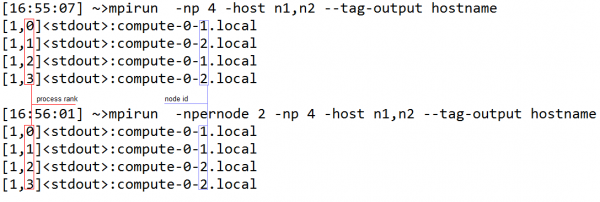sp_viper
Initial 3D Model - VIPER: ab initio 3D structure determination using Validation of Individual Parameter Reproducibility (VIPER). Determines a validated initial model using a small set of class averages produced by ISAC2.
Usage
Usage in command line
sp_viper.py stack directory --radius=outer_radius --sym=sym --moon_elimination=moon_elimination --ir=inner_radius --rs=ring_step --xr=x_range --yr=y_range --ts=translational_search_step --delta=angular_step --center=center_type --maxit1=max_iter1 --maxit2=max_iter2 --mask3D=mask3D --L2threshold=L2threshold --ref_a=ref_a --nruns=nruns --doga=doga --fl=fl --aa=aa --pwreference=pwreference --debug
Typical usage
sp_rviper exists only in MPI version.
mpirun --npernode 16 -np 24 --host node1,node2 sp_viper.py stack output_directory --fl=0.25 --radius=30 --xr=2 --moon_elimination=750,4.84
A faster version using restricted ranges of parameters.
mpirun --npernode 16 -np 16 --host node1 sp_viper.py stack output_directory --fl=0.25 --radius=30 --xr=1 --nruns=2 --L2threshold=1.0e300 --doga=-1
The VIPER program exists only in MPI version. Number of MPI processes must be a multiple of --nruns (default = 6).
Since VIPER uses group of processors working together, it is important for efficient execution to have processors within a group allocated to the same node. This way any data exchange within the group does not involve network traffic. The --npernode option of mpirun accomplishes this goal. As shown in the example below when --npernode is used MPI allocates the ranks of the processors sequentially, not moving to the next node until the current one is filled. If --npernode is not used then processors are allocated in a round robin fashion (i.e. jumping to the next node with each allocation). Since in VIPER, groups contain consecutively ranked processors, it is important to provide “--npernode XX”, where XX is the number of processors per node.
Input
Main Parameters
- stack
- Input images stack: A small subset of class averages produced by ISAC2. (default required string)
- directory
- Output directory: The automatically-created output directory will contain results. If the directory already exists, results will be written there, possibly overwriting previous runs. (default required string)
- --radius
- Particle radius [Pixels]: Use the same value as in ISAC2. It has to be less than half the box size. (default 29)
- --sym
- Point-group symmetry: Point-group symmetry of the particle. (default c1)
- --moon_elimination
- Eliminate disconnected regions: Used to removed disconnected pieces from the model. As an argument it requires a comma-separated string with the mass in KDa and the pixel size in [A]. (default none)
Advanced Parameters
- --ir
- Inner rotational search radius [Pixels]: Inner rotational search radius [Pixels]. (default 1)
- --rs
- Ring step size [Pixels]: Step between rings used for the rotational search. (default 1)
- --xr
- X search range [Pixels]: The translational search range in the x direction. Search will +/-xr range in steps of ts. (default '0')
- --yr
- Y search range [Pixels]: The translational search range in the y direction. If omitted it will be xr. (default '0')
- --ts
- Translational search step [Pixels]: The search will be performed in -xr, -xr+ts, 0, xr-ts, xr, can be fractional. (default '1.0')
- --delta
- Projection angular step [Degrees]: Projection angular step. (default '2.0')
- --center
- Center 3D template: -1: center of coordinates, 0: no centering; 1: center of gravity (default -1.0)
- --maxit1
- Maximum iterations - GA step: Maximum number of iterations for GA step. (default 400)
- --maxit2
- Maximum iterations - Finish step: Maximum iterations number of for Finish step. (default 50)
- --mask3D
- 3D mask: Path to 3D mask file. (default sphere)
- --L2threshold
- GA stop threshold: Defines the maximum relative dispersion of structures' L2 norms. (default 0.03)
- --ref_a
- Projection generation method: Method for generating the quasi-uniformly distributed projection directions. S - Saff algorithm, or P - Penczek 1994 algorithm. (default S)
- --nruns
- GA population size: This defines the number of quasi-independent structures generated. (default 6)
- --doga
- Threshold to start GA: Do GA when the fraction of orientation that changes less than 1.0 degrees is at least this fraction. (default 0.1)
- --fl
- Low-pass filter frequency [1/Pixels]: Using a hyperbolic tangent low-pass filter. Specify with absolute frequency. (default 0.25)
- --aa
- Low-pass filter fall-off [1/Pixels]: Fall-off of for the hyperbolic tangent low-pass filter. Specify with absolute frequency. (default 0.1)
- --pwreference
- Power spectrum reference: Text file containing a 1D reference power spectrum. (default none)
- --debug
- Verbose: Print debug info. (default False)
Output
Description
- This program uses a Genetic Algorithm (GA) strategy to deliver a validated 3D ab initio structure. It will first compute simultaneously ab initio structures
- whose number will be equal to the population size. Next, it will compare solutions and apply evolutionary operators (merge some of the solutions)
- to produce their offsprings, which subsequently are used as initial structures for the next generation of GA processing.
- By default, structures in the first generation are initialized randomly.
- However, the program will start alignment from the alignment parameters xform.projection stored in file headers, if provided.
- The program only change the alignment parameters in header. The images in stack are untouched. (Neither rotated nor shifted.)
Method
Reference
Developer Notes
Author / Maintainer
Pawel A. Penczek
Keywords
Category 1:: APPLICATIONS
Files
sparx/bin/sp_viper.py
See also
Maturity
Beta:: Under evaluation and testing. Please let us know if there are any bugs.
Bugs
There are no known bugs so far.
